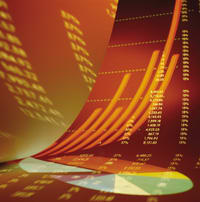street
sense
Don't Rush into Dividend Stocks
Corporate dividends are now taxed at 15%. But don't buy stocks just for a high current yield.
 By Jerry Helzner
By Jerry Helzner
It's certainly good news that cash dividends on common stocks are now being taxed at a maximum rate of 15%. But before you run out and buy a slew of the highest-yielding stocks, remember that not all dividend-paying stocks are created equal. This month, I'll provide guidance on selecting the stocks of dividend-paying companies that have more going for them than just a relatively high current yield.
Today's Yields Seem Puny
First, I'd like to offer a bit of perspective on dividends. For many decades, stocks of companies whose dividends provided an annual return of less than 5% weren't even considered in the high-yield category. It's only in recent years that returns on bonds, certificates of deposit and money market funds have fallen so low that a 3% yield on a stock qualifies as a high yield. If we ever get an across-the-board rise in interest rates, stock dividend yields will have to go up to attract income investors, and that means stock prices will have to come down. So that 3% yield you can get today may not seem so attractive 3 years from now.
|
|
|
|
PHOTOGRAPHER: JEAN LOUIS
BATT |
But assuming interest rates remain fairly stable for a while, how can we create a portfolio of relatively high-yielding stocks without taking a major risk?
The biggest risk one can take in buying a dividend-paying stock is that the dividend will be reduced, or even worse, completely eliminated. Dividend reductions and eliminations occur when a company's earnings drop to the point where it can't sustain the current payout level.
Unfortunately, many investors don't look very far into the future and buy stocks that have attractive current yields, failing to realize that a dividend cut or elimination will kill a stock's price quicker and more dramatically than almost any other kind of corporate event.
Is the Dividend Safe?
If you're buying a stock primarily for its dividend, you must be sure that the current dividend payout is secure and sustainable. Otherwise you could get badly burned.
In fact, if the dividend yield looks too fat, it's almost always a sign that the payout is shaky and is likely to be reduced.
For example, as I write this, you can buy shares in Altria (the new name for Philip Morris Companies) and receive a 6% dividend yield. Sounds good, right? But Altria's legal situation is so tangled that one adverse court decision connected to the company's tobacco business could wipe away almost all of Altria's net worth. The high current dividend yield is an indication of Altria's legal problems.
To be on the safe side, you're probably going to have to set your sights on a 3 to 4% dividend yield if you want to stay away from "problem" companies. You'll have to limit yourself to choosing from among those companies that are almost certain to be able to continue to deliver earnings large enough to sustain the level of the dividend payout.
Which companies are we talking about? In the major company category, firms such as H.J. Heinz, Conagra Foods, Chevron/Texaco and Fleet Bank seem capable of sustainable dividend payouts. But it wasn't long ago that companies such as pharmaceutical maker Schering-Plough and energy producer El Paso also seemed capable of generating a steady stream of dividends. Those expectations fell apart when business conditions forced these companies to conserve cash.
So if you're going shopping for dividend-paying stocks, make sure that you choose companies whose dividend payouts can stand the test of time.
Ophthalmology Management Associate Editor Jerry Helzner has written more than 50 articles on stock investing for Barron's. He has been a regular stock market columnist for other business publications and was a member of the equity research department of a major regional brokerage firm.









